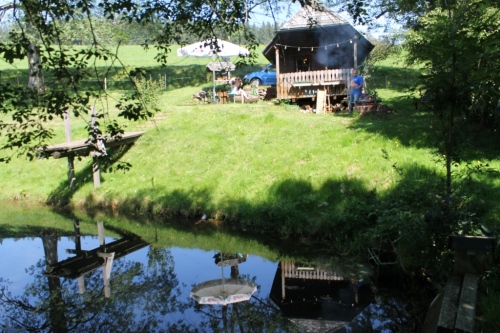We’ve left the Schwarzwald, taking with us a few extra pounds of fat and memories of early mornings, fresh pine forests, and fresh cow dung. Unfortunately, a certain scent, which can only be described as slightly fishy and rather unpleasant, permeated our luggage at some point. As clothes-washing facilities were not available to us until a few days after leaving the farm, we’ve had to put up with the occasional unpleasant whiff coming from our clothes (I’m assuming this wasn’t too awesome for the people around us either).
Our next stop was beautiful blue Lake Geneva, where we spent 2 nights at a wonderful little hotel near Nyon.
View of the lake and mountains from Nyon:
Brocante market in Nyon:
We met up with Anna and most of her family who were celebrating Anna’s brother’s 50th birthday. We all had a very nice meal at the hotel, followed by games of night-tag. Anna’s family members speak primarily Swiss-German, but are also all fluent in French and English, and all three languages were flying around the dinner table.
All-in-all it was a very nice and relaxing holiday. Getting there however was neither nice nor relaxing.
We took a train from the Schwarzwald to Basel (a city on the border with Germany), but continuing by train to Nyon was going to be very expensive, so we decided to try hitch-hiking. We managed to get a ride from the city of Basel to an AutoGrill on the highway where we proceeded to spend a few hours getting more and more frustrated. Eventually we got a ride to Bern, which was only about a third of the way, so we decided to take a train from there. The trip took us about 6 hours longer than it should have and we got to Nyon completely exhausted, but we managed to save a whopping 52 Swiss Franks (43 euro)! Not really worth it at all. The view of the sunrise from our room the next morning made things a bit better though:
Even though our first long distance hitch-hiking attempt wasn’t a complete success, we decided to give it another go. This time an even more bold journey: Nyon to Montpellier. By car it should have taken just under 5 hours. It would have cost about 180 euro to take the train all the way, which we thought was a bit steep.
We were hoping to get to Montpellier by 3:45 pm so we could catch the last direct bus to Prémian (back to our first wwoof hosts at Les Seilhols); however, we had a bit of a late start and didn’t get into Geneva until noon, so we had no chance of getting to the bus on time. We were dropped off in the center of town and didn’t know exactly where to go from there.
Geneva, it’s okay:
Rather than risk walking through the suburbs for several hours trying to find the right highway onramp, we decided to bite the bullet and take the train to Lyon. Thanks to a Swiss surcharge, this ended up costing 70 euros. In Lyon we were faced with the same problem, so we took a short train to a nearby town to the south called Vienne, spending another 15 euros. By this time it was 5 pm.
We got a ride from a guy who took us closer to the main highway. From there we got picked up by an Algerian man. He played the same song over and over and took the slowest road possible through all the crappy towns in the Rhone valley. We ended up in a dump called Le Pouzin. It was 7 pm and we were less than halfway there, so we decided to give up for the night. We also decided to sleep in the rocky hills behind the town in order to save money. Not quite 5 star accommodation, but pretty good for the price:
Despite having a not very refreshing sleep (camping without a tent or any sort of blanket doesn’t work that well in most places), we got an early start the next morning and set off determined to make it all the way to Montpellier. We got picked up quite easily, but each time they were only going a little ways in the right direction. Four rides took us from Le Pouzin to Pierrelatte, a whopping 50 km to the south. We still had another 140 km to go and we were tired and sweaty and sore and just wanted to get there, so we hopped on the train.
Forty euros later we were on our way to Montpellier. It was supposed to get in at 1:30, plenty of time to have an ice cream and check out the town before catching the bus. Unfortunately, we were delayed in Avignon for almost two hours for some reason. We got into Montpellier just before 3 pm, only to discover that the bus station had been moved to the outskirts of the city. We got on a tram with 30 minutes before the bus left and 17 stops before we got the station. We got there about 5 minutes after it was scheduled to leave. Luckily it was a bit late, we still had some energy left to chase the it down as it was leaving, and the driver was nice enough to stop for us. Two hours later, we were back at Les Seilhols. First order of business was a hop into the creek for a good clean.
We ended up saving only 50 euros and it cost us an extra day of travel, but at least we tried. Now, it’s time to do something about that horrible smell on our clothes, then go dig up some potatoes…























